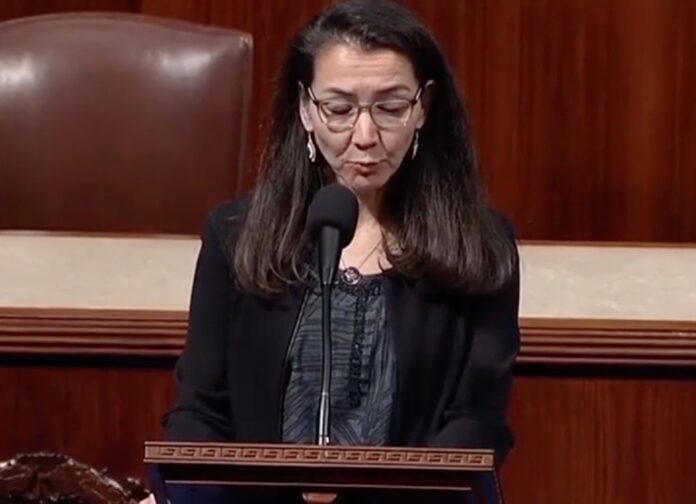Rep. Mary Peltola has legislation to use taxpayer funds to build bison herds on reservation and tribal land in the Lower 48.
H.R. 6368 funds a program within the Department of the Interior to assist tribes and tribal organizations with protecting, conserving, and fostering buffalo herds.
The federal government already has already dedicated over $25 million in taxpayer funds for such efforts. The funding was contained in last year’s climate bill, also called the infrastructure bill, in which the federal government will also transfer bison from federal land to tribal lands. An order from Interior Sec. Deb Haaland, in addition, has ordered the government to use indigenous knowledge in an effort to conserve bison.
Currently, there are approximately 440,500 Plains bison in conservation and commercial herds, according to U.S. Fish and Wildlife. Before the West was settled by those of European descent, bison numbered 50 to 60 million. They were hunted to about 1,500, but have since recovered.
“Tribes deserve to steward their own lands and manage their own resources. I’m proud to join a group of bipartisan legislators to reintroduce the Indian Buffalo Management Act–a bipartisan bill my predecessor supported–to restore Indigenous conservation and protection of buffalo,” Peltola said.
The Indian Buffalo Management Act provides taxpayer money for tribes and tribal organizations that have an established buffalo herd, as well as provides taxpayer money for tribes that would like to establish new herds.
“This holistic effort will ensure that this powerful sacred animal is reconnected to its natural habitat and the original stewards who know best how to care for it,” Sec Haaland said this year during a World Wildlife Day event in Washington, D.C.
“The American buffalo, a North American species of bison, once roamed freely across the United States and served an essential role for Native communities throughout North America. Historically, bison were a reliable source of food, shelter, and clothing for Indigenous peoples across the American West,” Peltola said in a statement. “The decimation of the American buffalo that began in the mid-19th century significantly harmed the Native communities that depended on these majestic creatures. Recognizing what buffalo mean to these communities, H.R.6368 establishes a program within the Department of the Interior to assist tribes and tribal organizations with protecting, conserving, and fostering buffalo herds.
The bill will help bolster tribal sovereignty, create economic opportunities, and ensure a stable supply of nutritious, locally sourced protein, she said. She did not say whether the bison would be available as protein to non-tribal members.
The bill was referred to the House Natural Resources Committee, on which Peltola is a member.
Bison, like other grazing animals, trample fragile vegetation that anchors soil and helps prevent erosion in the dry Southwest. Bison also produce greenhouse gases. According Chris Helzer, the prairieecologist.com author, bison are just as hard on the environment as cattle.
“Plains bison nearly disappeared completely from the grasslands of North America as European settlement spread across the continent. The ongoing recovery of bison is an important indicator of prairie conservation success, and I hope that upward trend continues. At the same time, I worry about the tendency of some to heap accolades upon bison while dismissing cattle as inherently destructive. The differences between them simply don’t warrant that kind of broad categorization. If grassland conservation is our goal, we should be sure we’re open to using whatever strategies (or animals) can help achieve that. In very large prairies, bison may be the best fit – assuming the logistics and costs of owning bison make sense. In other situations, however, deciding whether bison or cattle are most appropriate is not a simple matter. It’s a decision that should be based on facts and management objectives – not on aesthetics or mythology,” Helzer writes.

I’m all for more buffalos. However, isn’t this contrary to her party’s claim that these animals produce high levels of methane and are responsible for global warming? You can’t straddle the fence without hurting yourself.
Where is the money coming from? She’s been busy shutting down business’ and oil in her home state of Alaska.
Mary Peltola is a complete embarrassment to Alaska.
“Tribes deserve to steward their own lands and manage their own resources.”
They do, using THEIR OWN RESOURCES.
Many tribal governments on the plains own bison herds. There are hunts in Montana when bison leave Yellowstone. Let the tribes work with each other and the NPS to tranquilize bison in the park and form new herds where they want. State fish and game departments and university agriculture departments can and should assist in this endeavor. It requires NO federal funding.
Of course she does.
Smells racist and unAlaskan.
I like it. You used to have to wait days for the herd to pass before you could continue on your way.
The double standards of the left are hilarious. So much cognitive inconsistency to suit themselves. Guess she hasn’t received the bug eating memo.
Another government boondoggle that’s nothing more than a waste of taxpayer’s money.
If bison numbered 50 to 60 million and produced all
those greenhouse gases, how did the earth survive it ??
Next to come (after the newly hatched plan to increase grizzly bear numbers in the lower 48) will be the cry of economic hardship from herd loss due to bears doing what bears do.
Trust that the hand ( Palm sign up) will again be outstretched.
“Best” of all, between RVC and the general apathy of conservative voters,
She has a excellent chance of being re-elected.
I think this one good thing. Does not have anything to do for Alaska–which by the way– has some bison.
Our bison in Alaska were not a result of taxpayer money.
Gasless cows (Bison) who knew, thank you for the Democratic update.
Oh it’s a foregone conclusion. Make bank.
Comments are closed.